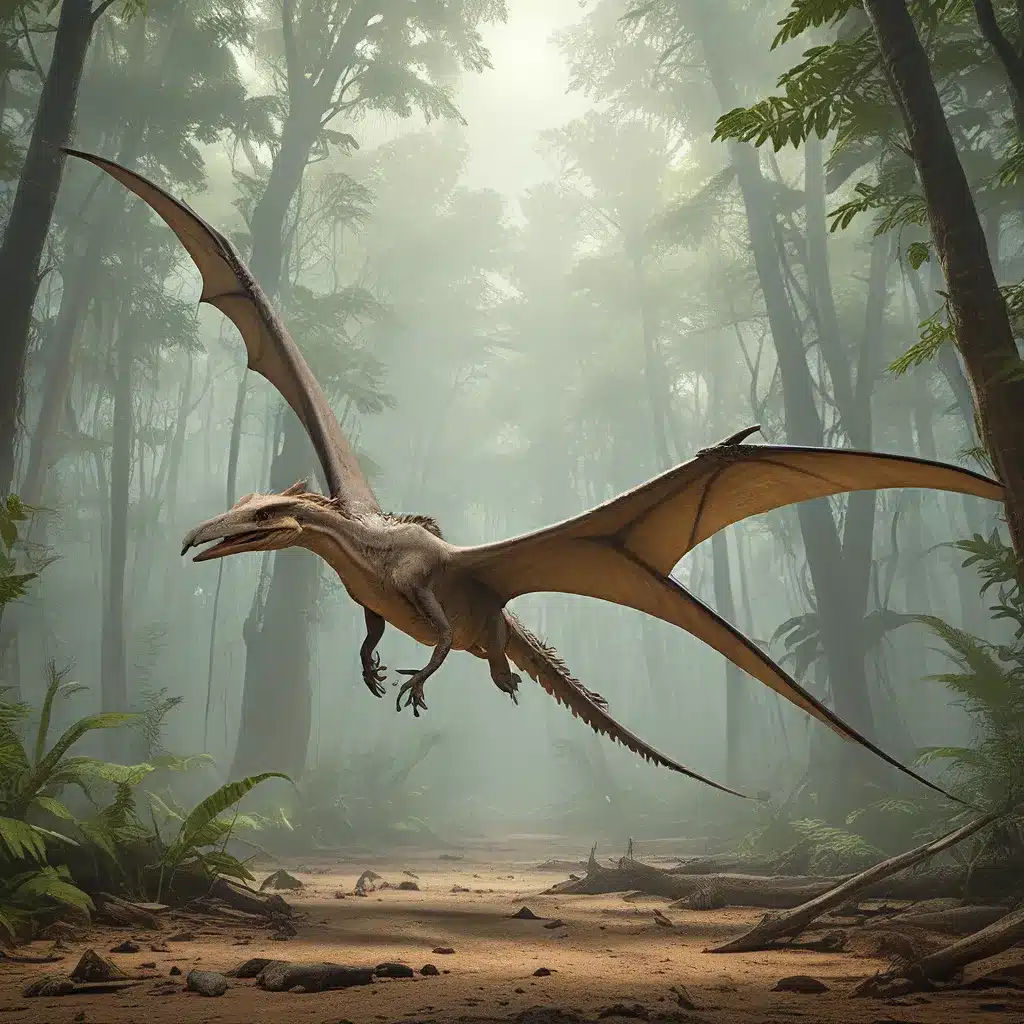
The Aerial Dominance of Pterosaurs
In the vast expanse of the Mesozoic era, the skies belonged to a truly remarkable group of creatures – the pterosaurs. These winged wonders were the first vertebrate animals to conquer the airspace, long before the rise of birds. For over 160 million years, they reigned supreme, evolving some of the most extraordinary anatomical adaptations ever seen in the animal kingdom.
Pterosaurs were not mere gliders; they were powered fliers, with a remarkable ability to navigate the skies with grace and efficiency. From the diminutive sparrow-sized species to the colossal behemoths with wingspans rivaling that of a modern fighter jet, these ancient aviators showcased the remarkable diversity and adaptability of life during the Age of Dinosaurs.
Unraveling the Mysteries of Pterosaur Flight
One of the enduring mysteries surrounding pterosaurs has been the mechanics of their flight. How did these massive creatures, some weighing over 650 pounds, manage to take to the skies? The answer lies in their remarkable skeletal adaptations and the unique properties of their wing membranes.
Researchers have discovered that pterosaurs possessed a remarkable combination of features that enabled their impressive aerial prowess. Their skeletons were remarkably lightweight, with hollow bones and thin, eggshell-like walls that provided strength without excessive weight. This featherweight frame was coupled with high-lift wing membranes that generated significantly more lift than the feathered wings of birds, allowing pterosaurs to achieve flight at slower speeds.
Arguably, the most critical adaptation was the quadrupedal launch of these ancient flyers. Unlike birds, which are bipedal and rely solely on their hind limbs for takeoff, pterosaurs could utilize their powerful forelimbs in addition to their legs, more than doubling the available launch power. This remarkable ability to generate the necessary thrust for liftoff was a key factor in enabling these giants of the sky to defy the constraints of gravity.
The Curious Case of Pterosaur Proportions
One of the most striking features of pterosaurs was their bizarre body proportions. These creatures had disproportionately large heads and necks compared to their relatively small bodies, a characteristic that has long puzzled paleontologists.
The skull of a typical Cretaceous pterosaur could be two or even three times the length of its body, with some species boasting a skull that exceeded four times the length of their torso. This extreme cephalization, or head enlargement, is coupled with neck vertebrae that are often twice the volume of the vertebrae in the torso.
Researchers have proposed several hypotheses to explain this remarkable anatomical adaptation. One possibility is that the large jaws and faces provided a significant advantage in hunting and signaling to mates and rivals, outweighing the potential drawbacks of carrying such a massive head. Additionally, the lightweight construction of the skull, with its air-filled cavities and large openings, may have helped to mitigate the burden of the oversized cranium.
Interestingly, the quadrupedal nature of pterosaurs’ locomotion on the ground may have also played a role in their ability to support such disproportionate head and neck structures. By using their powerful forelimbs to bear the weight of the head and chest, pterosaurs were able to minimize the burden on their hind legs, allowing them to maintain a stable and efficient gait.
The Rise and Fall of the Pterosaur Empire
For millions of years, pterosaurs reigned supreme in the skies, coexisting with their dinosaur cousins on the ground. However, their dominance was not to last forever. Around 150 million years ago, a new group of aerial competitors emerged – the birds.
Despite the arrival of these feathered flyers, pterosaurs continued to thrive, occupying a variety of ecological niches and dominating the open skies. Their large size and efficient soaring flight gave them a distinct advantage in the vast, unobstructed environments of the Mesozoic world.
Tragically, the reign of the pterosaurs came to a sudden and catastrophic end around 66 million years ago, when a cataclysmic asteroid impact wiped out the non-avian dinosaurs, including their winged counterparts. Unlike the birds, which managed to adapt and survive, the pterosaurs were unable to weather the global environmental upheaval that followed the impact.
Researchers believe that the large size and specialized soaring adaptations of many pterosaur species may have contributed to their ultimate demise. As the skies were blotted out by dust and debris, the ability to soar for extended periods became a liability, as the necessary thermals and updrafts were disrupted. Meanwhile, the smaller, more adaptable birds were able to find refuge and food sources that the massive pterosaurs could not access.
The Legacy of Pterosaurs
Although the pterosaurs have been extinct for millions of years, their legacy lives on, both in the fossil record and in our modern understanding of the limits of animal form and function. These aerial giants have inspired new technologies, including innovative aircraft designs, and continue to captivate scientists and the general public alike.
The study of pterosaurs has provided valuable insights into the evolution of powered flight, the biomechanics of large-bodied flyers, and the complex interplay between an organism’s anatomy and its environmental niche. As we continue to uncover new fossils and refine our understanding of these remarkable creatures, the mysteries of the pterosaur’s reign may yield even more remarkable discoveries about the history of life on our planet.
The story of the pterosaurs is a testament to the extraordinary diversity and adaptability of life during the Mesozoic era. From their humble origins as swift-footed ancestors to their reign as the undisputed masters of the skies, these winged wonders have left an indelible mark on our understanding of the past and our imagination of the future. By exploring the lost kingdoms of the past, we can better appreciate the remarkable resilience and innovation that have shaped the course of life on our planet.


